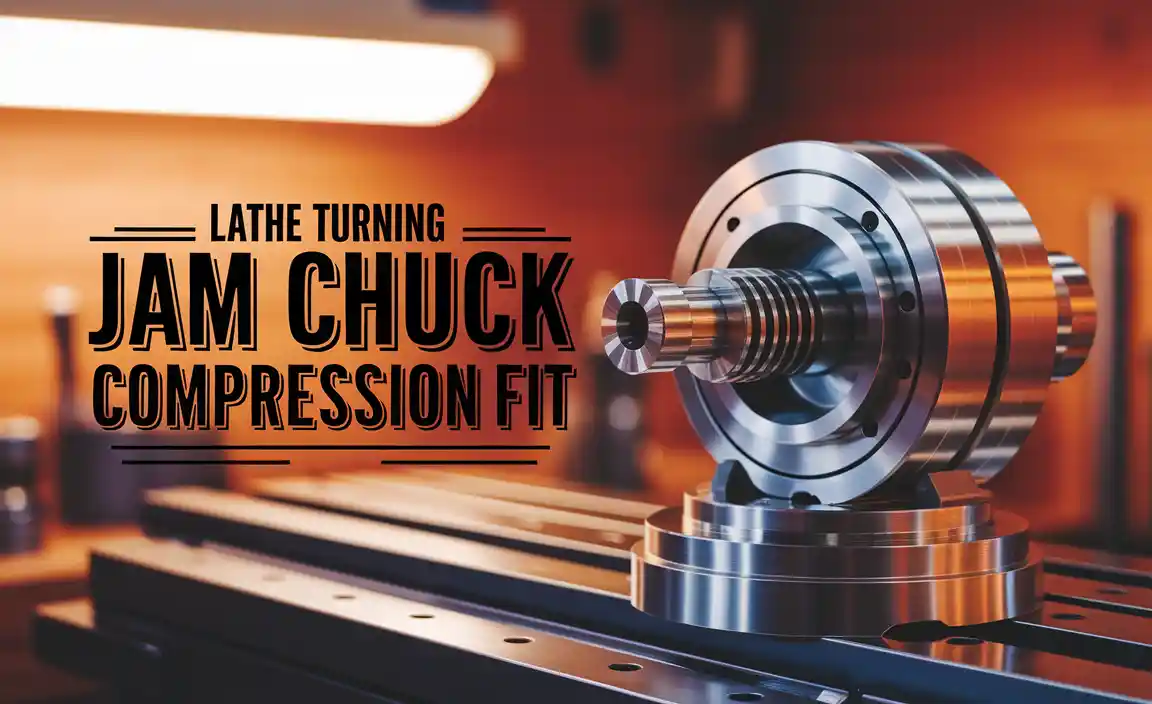Carbide end mills can achieve excellent tool life in Delrin by using the right speeds, feeds, coolant, and cutter geometry, making it a straightforward process for beginners.
Hey there, fellow makers! Daniel Bates from Lathe Hub here. Are you diving into machining Delrin and finding your carbide end mills aren’t lasting as long as you’d hoped? It can be frustrating when a tool wears out too quickly, especially when you’re just starting out. But don’t worry! Cutting Delrin with a carbide end mill is very doable, and getting great tool life is simple. We’ll walk through exactly how to make your end mills sing in Delrin, giving you predictable results every time. Let’s get your mill running smoothly!
Understanding Delrin and Carbide Tooling
Delrin, also known by its chemical name acetal or POM (polyoxymethylene), is a popular thermoplastic in machining. It’s loved for its stiffness, low friction, excellent dimensional stability, and resistance to chemicals. This makes it perfect for gears, bearings, bushings, and many other functional parts. Because it’s a plastic, however, it behaves differently than metals when being cut, and understanding these differences is key to maximizing tool life.
Carbide end mills are a fantastic choice for Delrin. They are much harder and more rigid than High-Speed Steel (HSS) cutters, allowing them to run faster and maintain their sharpness for longer. This rigidity is especially important in plastics, where softer tools can flex and rub, generating heat and causing premature wear. However, even with carbide, improper machining parameters can lead to issues like melting, chip recasting, and rapid tool degradation.
Why Tool Life Matters in Delrin Machining
Getting good tool life when machining Delrin isn’t just about saving money on cutters, though that’s a big part of it. It’s also about consistency and predictability in your machining process. When a tool wears out quickly:
- Part Quality Suffers: A dulling end mill can start to melt the plastic instead of cutting it cleanly. This leads to rough surfaces, poor tolerances, and even fused chips that can jam your part or machine.
- Process Becomes Unreliable: You can’t be sure if the last part you cut was to spec or if the tool is about to give up. This makes production, even on a small scale, very unpredictable.
- Increased Costs: Constantly replacing end mills adds up, especially for hobbyists or small shops.
- Frustration Builds: Nobody likes troubleshooting why their tools are failing when they just want to make something.
Our goal is to make your Delrin machining straightforward and your carbide end mills last. Think of it like a well-tuned engine – when everything is set correctly, it runs smoothly and efficiently for a long time.
Choosing the Right Carbide End Mill for Delrin
Not all carbide end mills are created equal, and some are better suited for Delrin than others. For optimal results, consider these features:
Flute Count
For Delrin, two-flute end mills are generally preferred. These offer a good balance of chip evacuation and cutting edge engagement. More flutes (like four-flute) can sometimes chatter or pack chips in Delrin, leading to melting.
Coating
While not strictly necessary for Delrin, certain coatings can help. Uncoated carbide is very common and works well. If you do see coatings, those designed to reduce friction or prevent material buildup (like TiCN or ZrN) can offer marginal benefits but aren’t usually worth the extra cost for Delrin specifically.
Helix Angle
A standard 30-degree helix angle is a good all-around choice. Very steep helix angles (high-performance) might be overkill for Delrin. Some specialized plastics end mills have higher helix angles to help evacuate chips better, which can be beneficial.
Edge Preparation
A sharp, polished cutting edge is crucial. This minimizes friction and prevents the Delrin from welding to the cutter. Many high-quality carbide end mills come with a sharp, ready-to-use edge.
For a common size like the “carbide end mill 3/16 inch 1/4 shank long reach for Delrin,” you’ll find plenty of options. The “long reach” aspect means you can control depth of cut more easily, which is also helpful. Focus on reputable brands known for quality tooling.
Recommended End Mill Types for Delrin
- 2-Flute, Uncoated: The most common and often the best starting point.
- 2-Flute, With a High Helix Angle: Can improve chip evacuation, especially in deeper cuts.
- Specialized Plastic End Mills: Often feature highly polished flutes and sometimes unique geometries designed for plastics.
Optimizing Cutting Parameters for Delrin
This is where the magic happens! Setting the right speeds and feeds is critical to preventing Delrin from melting and ensuring a clean cut with long tool life. The general principle is to remove material quickly enough to avoid heat buildup but not so fast that you overload the cutter.
Spindle Speed (RPM)
Delrin can be machined at relatively high spindle speeds. The key is to match the speed to the feed rate to achieve an appropriate chip load. A good starting point for a 3/16 inch end mill might be:
- Range: 8,000 – 20,000 RPM
- Typical Starting Point: Around 12,000 – 15,000 RPM
The exact RPM will depend heavily on your machine’s capabilities and the feed rate you choose.
Feed Rate (IPM – Inches Per Minute)
The feed rate determines how quickly the end mill advances into the material. This is directly related to the chip load – the amount of material each cutting edge removes per revolution.
Chip Load Calculation
A good chip load for plastics like Delrin is typically in the range of 0.001 to 0.003 inches per flute. To calculate the required feed rate:
Feed Rate (IPM) = Spindle Speed (RPM) × Number of Flutes × Chip Load (inches/flute)
Let’s plug in some numbers for a 3/16 inch, 2-flute end mill:
- Example 1: Speed = 12,000 RPM, Chip Load = 0.002 inches/flute
- Feed Rate = 12,000 RPM × 2 flutes × 0.002 inches/flute = 48 IPM
- Example 2: Speed = 15,000 RPM, Chip Load = 0.0025 inches/flute
- Feed Rate = 15,000 RPM × 2 flutes × 0.0025 inches/flute = 75 IPM
Always start at the lower end of the recommended feed rate and increase if the cut is too light or the chips are too small.
Depth of Cut (DOC) and Width of Cut (WOC)
For Delrin, it’s often best to take lighter depths of cut, especially in the initial passes. This helps manage chip load and heat. A good rule of thumb is:
- Depth of Cut (DOC): Start with 0.1 to 0.2 times the tool diameter. For a 3/16 inch end mill, that’s about 0.018″ to 0.037″. You can often go deeper, but it’s wise to ramp up slowly.
- Width of Cut (WOC): For pocketing, aim for a WOC of about 50% of the tool diameter (e.g., 0.1″ for a 3/16″ end mill). For contouring, you might be taking a full-width cut, which requires lighter DOC.
Using aggressive “high-efficiency machining” (HEM) or “adaptive clearing” toolpaths with light radial engagement and higher axial depth of cut can also work very well, as they maintain a more constant chip load.
Tabulated Parameters: A Starting Point
Here’s a table of recommended starting parameters for a 3/16 inch, 2-flute carbide end mill in Delrin. These are general guidelines, and you should always listen to your machine and adjust as needed.
| Parameter | Delrin (POM) – 3/16″ 2-Flute Carbide End Mill | Notes |
|---|---|---|
| Spindle Speed (RPM) | 12,000 – 20,000 | Higher speeds generally work well if feed rate is matched. |
| Chip Load (inches/flute) | 0.0015 – 0.003 | Adjust to achieve audible crisp cutting. |
| Feed Rate (IPM) | 36 – 120 | Calculated based on RPM, flute count, and chip load. |
| Depth of Cut (DOC) | 0.010″ – 0.075″ | Start lighter, increase gradually. Follow tool manufacturer’s recommendations for maximum DOC. |
| Width of Cut (WOC) | Slotting: Match tool diameter Pocketing: ~50% of tool diameter |
Lighter WOC in pocketing helps reduce heat. |
| Coolant/Lubrication | Recommended (Air Blast/Mist) | To prevent melting and chip recasting. |
For more advanced guidance on machining plastics, resources like the Machinable Blend Plastics Machining Guide offer excellent charts and tips.
Cooling and Chip Evacuation: Crucial for Plastics
This cannot be stressed enough: Delrin heats up quickly and can melt if you’re not careful. Proper cooling and chip evacuation are paramount for both tool life and part finish.
Air Blast
A steady stream of compressed air directed at the cutting zone is often the best and simplest method. It cools the tool and pushes chips away from the cutting area, preventing them from re-cutting or melting.
Misting Systems
A fine mist of coolant and air can provide even better cooling. However, ensure the mist is effective and doesn’t just make a mess. Some machinists use a water-based soluble oil diluted for plastics.
Flood Coolant
While effective for metal, flood coolant can sometimes be counterproductive with Delrin. It can wash chips into awkward places, and the plastic might not cool as efficiently as metal. If you use it, ensure it’s a formulation suitable for plastics and that your chip flushing is excellent.
Chip Evacuation Techniques
- Clear the Flutes: Ensure your end mill has adequate chip clearance. For Delrin, this is usually handled by the end mill’s flute design and a good air blast.
- Peck Drilling (for holes): When drilling deep holes, use peck cycles to clear chips.
- Strategic Toolpaths: Use toolpaths that allow chips to escape easily. Avoid deep, narrow slots if possible, or use a multi-pass strategy.
The goal is to keep the cutting edge cool and the chips moving out of the way. Think of it as keeping the area clean so the clean, crisp cuts can happen without interruption.
Common Problems and How to Solve Them
Even with the best intentions, you might run into a few snags when machining Delrin. Here are some common issues and their fixes:
1. Melting/Gooey Chips
Cause: Too much heat generated. This happens from insufficient chip load (rubbing instead of cutting), too slow a feed rate, dull tooling, or inadequate cooling.
Solution:
- Increase feed rate.
- Increase spindle speed slightly (if possible without exceeding chip load).
- Use a sharper end mill.
- Improve chip evacuation (air blast, mist).
- Take lighter depths of cut.
2. Chattering/Vibration
Cause: Machine rigidity, tool overhang, incorrect spindle speed, or feed rate not matching the chip load.
Solution:
- Reduce tool overhang.
- Ensure your workpiece is held securely.
- Adjust spindle speed to find a “sweet spot” where vibration minimizes.
- Ensure you have an adequate chip load (not too small).
- Use a coated end mill (sometimes helps dampen vibration).
3. Poor Surface Finish
Cause: Dull tool, chip recasting (melts and sticks back onto the part), incorrect speeds/feeds, or debris in the cut.
Solution:
- Use a sharp, high-quality end mill.
- Ensure proper cooling and chip evacuation to prevent melting.
- Lighten the depth of cut for finishing passes.
- Experiment with slightly different feed rates.
4. Tool Breakage
Cause: Taking cuts that are too aggressive (too deep or too wide), lack of rigidity, poor chip evacuation leading to jamming, or a defect in the tool.
Solution:
- Reduce depth and width of cut.
- Ensure your workpiece is securely fixtured.
- Use shorter tool lengths if possible to reduce deflection.
- Confirm adequate chip evacuation.
- Inspect tools for nicks or damage before use.
Maintaining and Inspecting Your Carbide End Mills
Even with optimal machining, your end mills will eventually wear. Regular inspection and proper care can extend their life significantly.
Visual Inspection
Before and after each job, visually inspect your end mill under good light, preferably with a magnifier.
- Cutting Edges: Look for any chipping, dulling, or signs of melting. A slightly rounded edge is normal wear, but visible flattening or chipping means it’s time to consider replacement or re-sharpening.
- Flutes: Check for built-up material or signs of excessive heat.
- Shank: Ensure the shank is clean; this is critical for tool holder gripping.
When to Replace or Sharpen
It’s often more economical to replace a small carbide end mill than to have it professionally re-sharpened, especially given the low cost of basic cutters. However, if you’re using very specialized or expensive carbide tools, re-sharpening might be an option. For most hobbyists and beginner machinists cutting Delrin:
- Replace when cutting performance noticeably degrades.
- Replace when you start seeing melting or poor surface finish despite optimal parameters.
- Pro Tip: Use your worn end mills for less critical tasks or to create chamfers on rougher materials, giving them a second life.
Advanced Machining Techniques for Delrin
Once you’re comfortable with the basics, you can explore some more advanced techniques:
High-Efficiency Machining (HEM) / Adaptive Clearing
These toolpaths, often found in CAM software, use a small stepover (radial engagement) and a larger depth of cut (axial engagement). This maintains a more consistent chip load, generates fewer, longer chips, and can lead to faster machining times and longer tool life in plastics like Delrin by managing heat and tool pressure more effectively.
Using a Ball-End Mill for Contouring
If you’re doing complex contouring or creating fillets, a ball-end mill is the tool of choice. For Delrin, a 2-flute ball-end mill with similar speed/feed principles will work well. Be aware that the effective chip load changes across the radius of the ball, so you might need to adjust slightly.
Fixturing Delrin for Machining
Delrin can be prone to deformation under pressure. Use shallow vices, double-sided tape, or custom fixtures that distribute clamping force evenly. Avoid overtightening. For very precise parts, consider chilling the Delrin slightly before clamping if it’s a concern, though this is rarely needed for most projects.
For more detailed machining strategies for various plastics, resources like Plastics Magazine’s Machining Guide can offer deeper insights.





